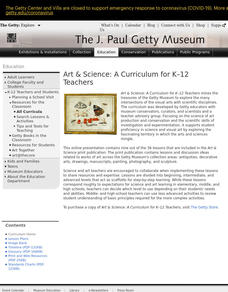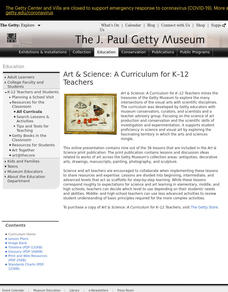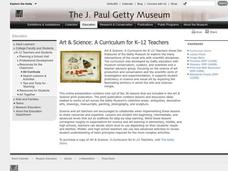Curated OER
Looking and Learning in the Art Museum
Reflect on the art your class can view at a museum. In this art history lesson, students draw six elements of art. They discuss original art versus reproduction artwork and write about their thoughts of a museum. It would be wonderful if...
Curated OER
Using Primary Sources: Letters from the Presidents
Students research the life of a president by reading personal letters on the American Presidents web site, and explore the ways that the character and personality of the president affected the ways they handled historical events.
Curated OER
Animal ABC Book
Students in class choose a letter of the alphabet and uses the Enchanted studying web site to pick which animal they copy and paint for their letter. Students copy animal printout and paint or color it.
Curated OER
Teaching the Class about Community Helpers
Pupils use the computer to research information about community workers on the Internet. For this technology lesson, students pretend they are the teacher and that they have to share what they know about the community member chosen....
Curated OER
Lesson from the web
Students measure the circumference of an object to the nearest millimeter. They also measure the diameter. The relationship of the two measurements is taught and how the value of pi came into existence.
Curated OER
Looking and Learning in the Art Museum - Lesson 1
Explore the artistic elements in artworks with an original and reproduction instructional activity. As learners recognize the difference between an original and a reproduction, they discuss the artist elements used in the...
Curated OER
Looking and Learning in the Art Museum
Students explore art at an art museum. In this lesson about art, students travel to a museum and explore the art. Students practice drawing, search for certain kinds of art, and learn about reproducing art by someone else. Students will...
Curated OER
Celebration and Satire- Beginning Level
Students examine art elements in a late-19th-century self-portrait painting. In this visual arts activity, students analyze the painting "A Centennial of Independence" and identify the color, shape, and symbols in the art piece. Students...
Curated OER
Clearly Classified
Young scholars review the classification system for living organisms and apply it the classification of insects and flowers in the still life by Ambrosius Bosschaert. They create a chart classifying the animals and plants in the painting...
Curated OER
Our Illuminated Alphabet
Students examine artwork and create their own. In this writing and illustrating lesson, students view illuminated letters from the Getty Museum's collection and discuss art vocabulary. Students examine the visual elements in...
Curated OER
Jewel of the Mississippi Delta
Young scholars develop their own website to show the information they gathered about the Mound Bayou on the Mississippi Delta. After taking a field trip to the area, they create their own coloring books, stories and games to share the...
Curated OER
Finding Balance
Young scholars examine the relationships between force, mass and balance through the lens of clay sculpture. They discuss the definitions and concepts behind Newton's Third Law of motion then individually apply these principles to the...
Curated OER
Safe or Not Safe
Students discuss the safety signs they viewed on their way to school before looking at safety signs at a website that presents a traffic safety school for students. They listen to a read aloud of Tana Hoban's, "I Read Signs," make signs,...
Curated OER
18th Century Microscope
Students examine a microscope from the 18th century. In this microscope lesson plan, students investigate how it works, what it was used for and how the tool has evolved through the years. Students also build knowledge on how compound...
Curated OER
Disaster Relief - You Can Count On Me!
Students practice stewardship. In this service learning lesson, students respond to those in need after a natural disaster as they investigate philanthropy.
Curated OER
Clearly Classified
Learners investigate plants and insects. In this science classification lesson, students create separate categories for insects and plants by characteristics. Learners discover scientific names of insects.
Curated OER
Flawed Democracies, Human Rights
Students create drawing that tell a story about a young girl's life in an internment camp. In this internment camp lesson plan, students hear stories and analyze photographs of internment camps and then create their own drawings.
Curated OER
Finding Balance
Students explore how an artist uses the force of gravity to create balance in a sculpture. In this sculpting lesson, students create their own sculpture applying concepts from the lesson.
Curated OER
Medieval Natural Resources
Students discuss and view examples of the illuminated manuscripts that were created during medieval times and into the Renaissance. In small groups, they research the resources that were used to create the manuscripts and classify them...
Curated OER
Insect Anatomy
Learners explore the anatomy of an insect. In this activity the characteristics of insects, students explore parts of an insect. Learners gain knowledge through pictures and charts showing insects and their body parts. Students will...
Curated OER
Looking at French Decorative Arts: The Quest for True Porcelain
Pupils study the effects of production and consumption of goods on French society during the porcelain period. For this history lesson students research the trade history of porcelain from Asia.
Curated OER
Methods of Mystery
Students utilize the scientific method to discover the age of an item. In this historical dating lesson plan, students compare and contrast a 400 year old cabinet to one made within a few years by using carbon dating....
Curated OER
There's a Monster in My E-Mail!
Don't be scared of these monsters! Middle schoolers make new friends as they practice their drawing, writing, and computer skills. They participate in a collaborative e-mail project in which they draw and describe pictures of monsters...
Curated OER
Alphabetize For A Reason
Learners organize information by using the alphabet. Students organize materials alphabetically. Learners alphabetize with the first, second and third letters of a set of words. Students discover applications for alphabetical order.























